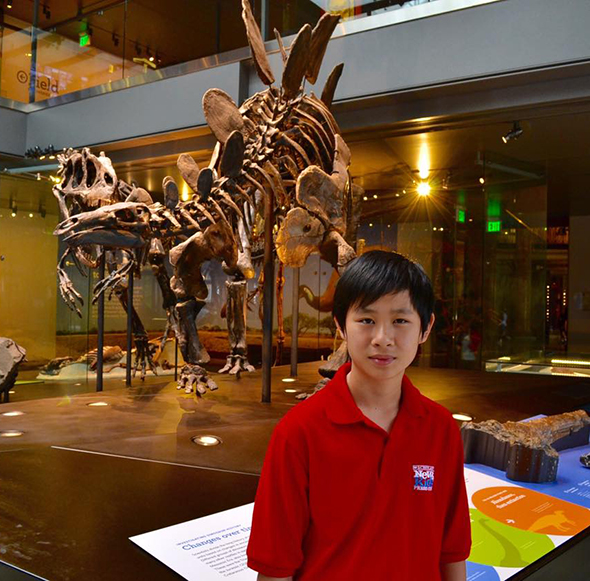KID REPORTERS’ NOTEBOOK
Jurassic World Roars Into Theaters


Jeremy in front of a Stegosaurus at the Natural History Museum in Los Angeles
Jurassic World roars and rampages its way into theaters on June 12. Watching the movie is like riding a roller coaster. It is both terrifying and exhilarating.
The plot goes something like this: After trying and failing many times to build a dinosaur theme park, International Genetics (InGen) scientists manage to create Jurassic World. The scientists later dream up a genetically modified dinosaur, Indominus Rex, to boost attendance rates.
Things go very wrong when the dinosaur breaks out of its cage in a frenzied quest for food. It is up to Owen Grady (Chris Pratt), a Velociraptor trainer, and Claire Dearing (Bryce Dallas Howard), the park operations manager, to stop the runaway dinosaur and save the park.
Thirteen-year-old Ty Simpkins plays Gray Mitchell, one of Dearing's nephews. I asked him in a phone interview what it was like to work with dinosaurs that are computer-generated. To simulate the dinosaurs during filming, Ty explained, “There were actors in gray jumpsuits with raptor bicycle helmets on."
Colin Trevorrow, the director of Jurassic World, seems to have achieved his goal of recapturing the adventure and exhilaration of the first Jurassic Park movie. The visual and special effects make Jurassic World a must-see in IMAX 3D. However, the film may not be suitable for a younger audience because it is full of bloodshed and violence.
"BE CAREFUL"
In the first Jurassic Park film, which debuted in 1993, actor Jeff Goldblum played Dr. Ian Malcolm, a mathematician and chaos theorist who helped certify that the park was safe. Said Malcolm: “Your scientists were so preoccupied with whether or not they could create something that they didn't stop to think about whether or not they should.”
For Jurassic World, paleontologist Jack Horner led a team of scientists who came up with the computer-generated genetically modified dinosaurs. "We have new hybrid dinosaurs that are mixtures of several dinosaurs, plus mixtures of genes from other kinds of animals," Horner said.
With technology advancing by leaps and bounds, could we some day have real-life hybrid dionsaurs? Is it even a good idea?
Ty expressed mixed feelings. “It would be awesome,” he said. “But you’ve got to be careful, and keep it small.”
